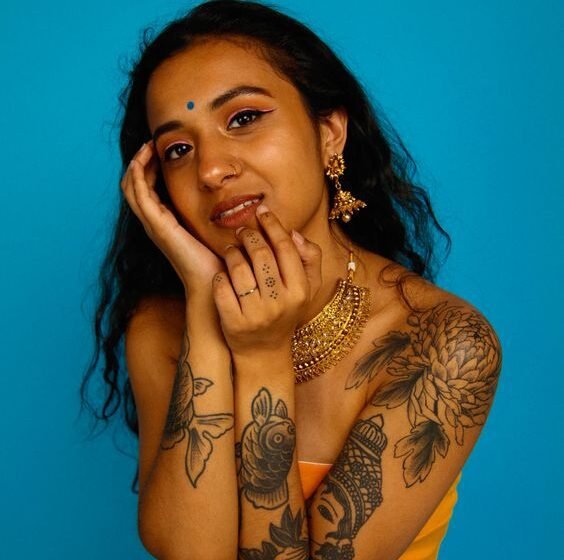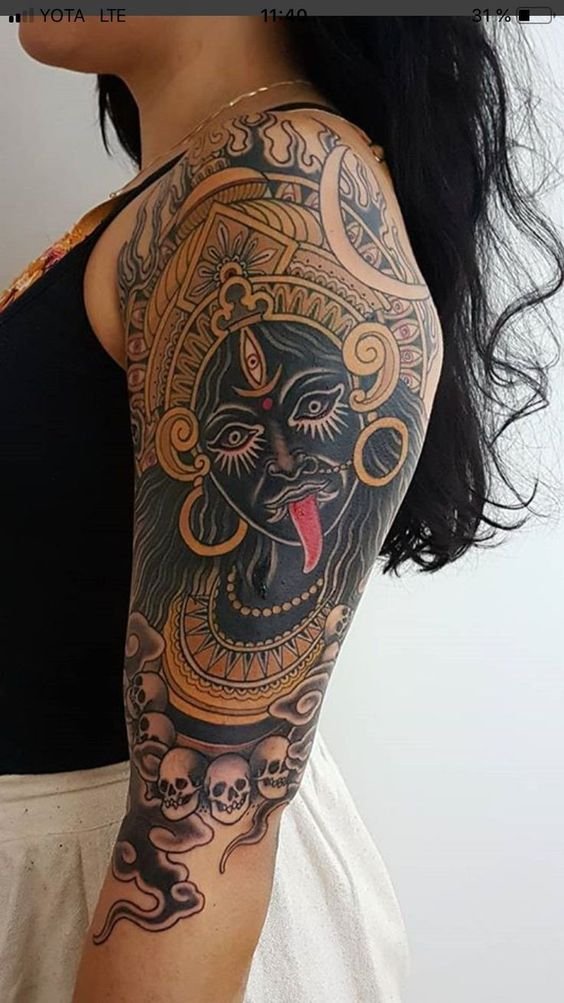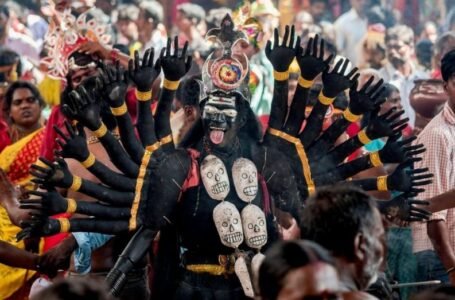Reviving Traditional Indian Tattoos: Exploring Designs, Techniques, and Preservation

The popularity of traditional Indian tattoo designs and techniques has experienced a surprising comeback. This resurgence represents a deep reconnecting with the rich creative and cultural past of the Indian subcontinent rather than just a fad. Indian traditional tattoos are more than just designs applied to the flesh; they are detailed stories interwoven into the fabric of time. In tandem with the rapid advancement of contemporary India, efforts are being made to conserve and bring back the traditional tattooing customs that have long been a vital component of the nation’s rich cultural heritage.

Within the complex fabric of Indian culture, traditional tattoos are a singular and alluring feature. These ancient artistic traditions, which are steeped in the history of the country, have seen a spectacular comeback in recent years. With the expansion of globalization and modernization, there is a growing push to conserve and bring back India’s traditional tattooing techniques. This rebirth is a significant attempt to honor craftsmanship, establish a feeling of identity and pride, and re-establish ties to one’s heritage, it goes much beyond simple skin decoration.
Exposing the Historical Importance:
One must examine the profound historical importance of traditional Indian tattoos to comprehend their recent rebirth. For millennia, tattoos have been an integral aspect of Indian culture, existing beyond of temporal and spatial boundaries. Indian tattoos have roots in several ancient civilizations that once inhabited the subcontinent. Numerous cultures, each with its distinct symbolism and method, have covered their bodies with tattoos: from the tribal people of the Northeastern states to the Dravidian communities in the South, and from the indigenous people of the Western Ghats to the Rajput warriors of the North.
In Indian culture, tattoos represented more than just one’s physical appearance; they were an integral part of one’s identity, heritage, and life path. They served as symbols for social standing, religious convictions, and even personal achievements. Stories of valor, love, religious dedication, and cultural history were frequently depicted in tattoos. Tattoo artists were highly regarded for their talent and artistry, and their elaborate storytelling via ink and flesh was a testament to their expertise.

The Modern Resurrection:
While traditional tattooing in India saw a brief dip due to modernization and globalization, there has been a noteworthy recovery in recent years. Several things have contributed to this resurgence, such as a greater awareness of indigenous art traditions, a resurgence of interest in cultural heritage, and a desire for distinctive and meaningful body art. Furthermore, social media platforms have been instrumental in presenting these excellent designs to a worldwide audience, resulting in heightened interest and appreciation. To replicate and reinterpret traditional Indian tattoo designs, modern tattoo artists are finding inspiration in historical documents, antiquated artwork, and indigenous cultures. These patterns frequently feature geometric patterns with profound spiritual and cultural meaning, religious iconography, and natural elements. The authenticity of the method is further enhanced by the revival of the use of natural dyes and pigments.
The Works of Preservation and Revival:
Awareness of the need to conserve and bring back traditional tattooing techniques has led to the development of several projects throughout India. Historians, anthropologists, and ethnographers have traveled to far-off places to record the disappearing customs and methods. These initiatives are essential for both the resurgence of the art form and our comprehension of the cultural environments that gave rise to these tattoos. To preserve traditional tattooing customs, several groups are collaborating closely with indigenous people. This ensures the continuation of this special legacy by transferring knowledge and skills from the elder generation to the younger. The history and significance of traditional Indian tattoos are also being taught to both Indians and foreigners through workshops, exhibitions, and seminars that tattoo studios and cultural organizations are combining to host.

Difficulties and Ethical Issues:
Although it is a positive development, the resurgence of traditional Indian tattoos is not without its difficulties. Preserving the art form’s authenticity is one of the fundamental issues. As demand increases, there’s a chance that the original tattoos may be diluted and commercialized, resulting in flimsy replicas that fall short of the mark. This emphasizes the necessity of tattooing with responsibility and ethics while respecting the art’s cultural and historical relevance. Additionally, it is crucial to respect the cultural background. Spiritual rites and beliefs are at the core of many traditional Indian tattoos. To properly work with these patterns, artists, and aficionados need to be sensitive to cultural differences and eager to learn about their history. This makes sure that the art form isn’t devalued or turned into a simple fashion accessory.

The Path Ahead:
The rebirth of traditional Indian tattoos is about more than simply body adornment; it’s about honoring cultural diversity, connecting with the past, and accepting the meaningful messages these tattoos convey. This rebirth serves as a reminder that development does not always have to come at the expense of cultural legacy as India advances in the twenty-first century. It is evidence of the enduring power of traditional artistic forms that enthrall and inspire people in the contemporary era.

Conclusion:
In conclusion, The encouraging resurgence of traditional Indian tattoo styles and motifs is evidence of the lasting value of artistic expression and cultural legacy. With the help of committed tattoo artists, scholars, and cultural lovers, these antiquated customs are making a comeback in popular culture. This Renaissance is about more than simply skin decoration; it’s about accepting oneself, respecting customs, and incorporating historical elements into contemporary life. India’s ancient tattooing methods will live on as long as there are people who value and appreciate the stories these tattoos convey.
It is crucial to approach traditional Indian tattoos with a combination of inventiveness, devotion, and honesty if one is to genuinely appreciate their history. Tattoo artists and lovers need to comprehend the cultural and historical backgrounds of these designs. By doing this, people may meaningfully engage in a conversation between the past and present in addition to helping to preserve a historic work of art. These tattoos serve as a constant reminder of the richness and beauty of the human experience by etching the histories of whole generations, cultures, and civilizations into our flesh.


